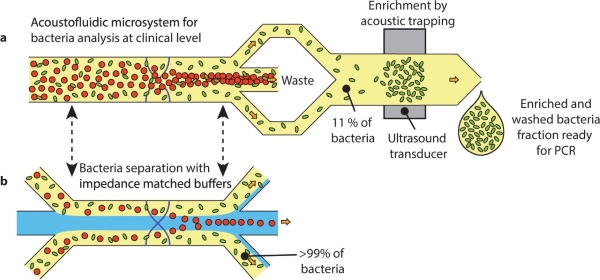Bacteria isolation
Direct separation and detection of bacteria
Sepsis is a systemic response to an infection and can be deadly. It is most often caused by bacteria, but concentrations of the causing pathogen in a blood sample is typically extremely low. The gold standard is to culture the blood sample for hours to days before detection, which may delay appropriate treatment until it is too late. We are therefore developing methods to separate out and detect bacteria directly from blood samples without previous culture.
Separation and enrichment of bacteria from blood sample. (Adapted from reference 1 under the Creative Commons Attribution 4.0 International License.)
Selective lysis and gradient acoustic focusing
Bacteria could be acoustically separated from blood cells since the larger blood cells are more affected by the acoustic forces than the smaller bacteria [1]. This separation was combined with acoustic trapping [2] to enrich and wash the bacteria before PCR detection, making it possible to detect bacteria in patient samples [3]. Some bacteria were lost in the separation, however, likely due to adhesion to blood cells or clustering.
To increase the bacteria recovery and improve the sensitivity of the method we are now developing an improved method based on selective lysis of the blood cells, followed by gradient acoustic focusing of the bacteria from the lysate [4]. The intention is to develop a faster method to detect sepsis causing bacteria from blood samples, which would save lives.
Similar methods could also be used to separate bacteria and other pathogens from other samples, such as for instance drinking water [5, 6].
Publications and selected presentations
- Acoustic impedance matched buffers enable separation of bacteria from blood cells at high cell concentrations, Pelle Ohlsson*, Klara Petersson*, Per Augustsson and Thomas Laurell, Scientific Reports, volume 8, article number 9156 (2018), doi: 10.1038/s41598-018-25551-0
- Seed particle-enabled acoustic trapping of bacteria and nanoparticles in continuous flow systems, Björn Hammarström, Thomas Laurell and Johan Nilsson, Lab Chip 2012
- Integrated acoustic separation, enrichment and microchip PCR of bacteria from blood for rapid sepsis diagnostics, Ohlsson, P.*,Evander, M.*, Petersson, K.*, Mellhammar, L., Lehmusvuori, A., Karhunen, U., Soikkeli, M., Seppä, T., Tuunainen, E., Spangar, A., von Lode, P., Rantakokko-Jalava , K., Otto, G., Scheding, S., Soukka, T., Wittfooth, S., and Laurell, T., Analytical Chemistry, 2016, 88 (19), pp 9403–9411, DOI: 10.1021/acs.analchem.6b00323
- Gradient acoustic focusing of sub-micron particles enables separation of bacteria from blood lysate, David van Assche*, Elisabeth Reithuber*, Wei Qiu, Thomas Laurell, Birgitta Henriques Normark, Peter Mellroth, Pelle Ohlsson, Per Augustsson, Scienetific Reports 2020, doi.org/10.1038/s41598-020-60338-2
- Continuous acoustic sorting of E. coli and G. Lamblia in drinking water, Xia, Y., Lei, L., Zhang, J.B., Ohlsson, P., Laurell, T., Yang, Z.H., Zhang, H.X., and Liu, A.Q., poster presented at µTAS 2014, San Antonio, Texas, USA
- Acoustophoretic microfluidic chip for microbial pre-concentration and fractionation in drinking water, Lei, L., Ohlsson, P., Chin, L. K.. Laurell, T., Liu, A. Q., presented at SIWW 2014

